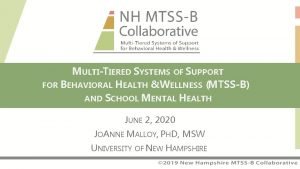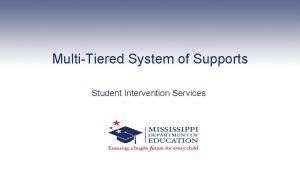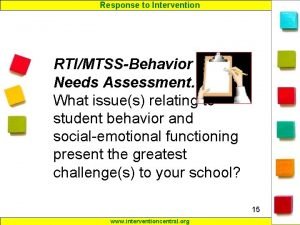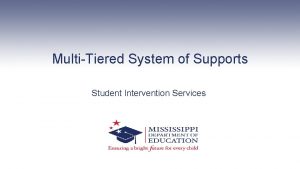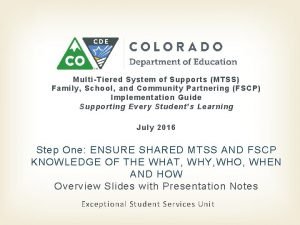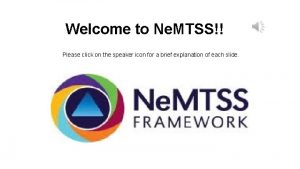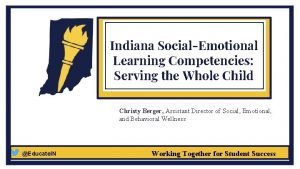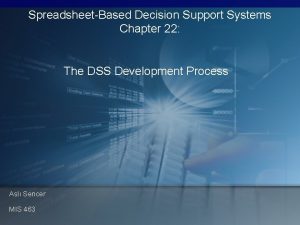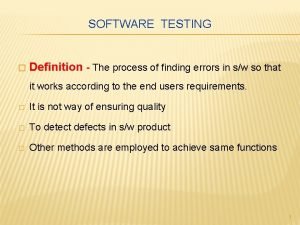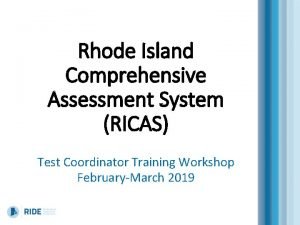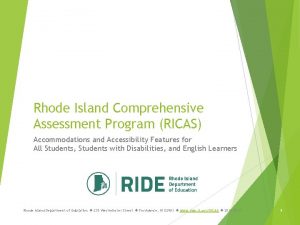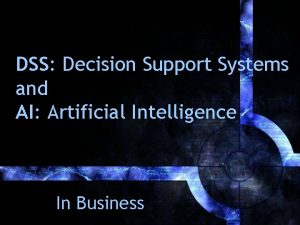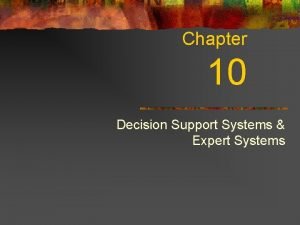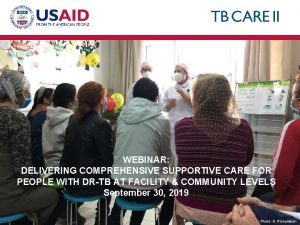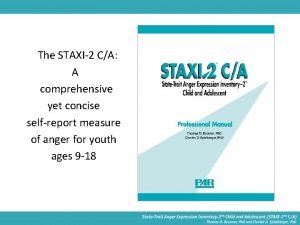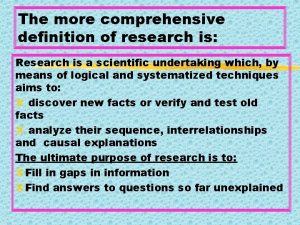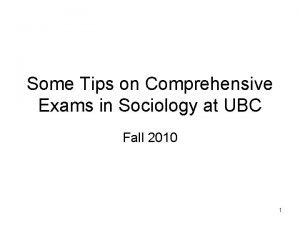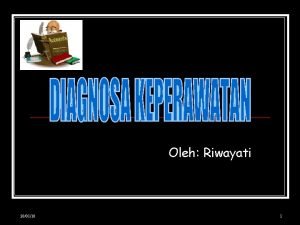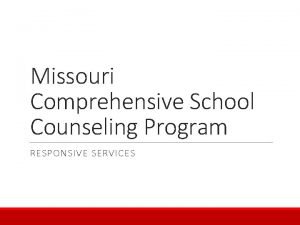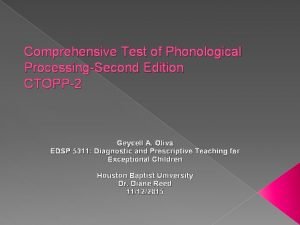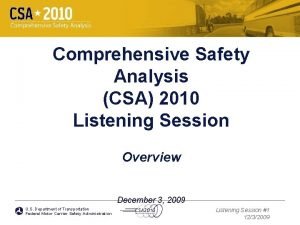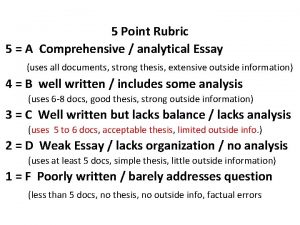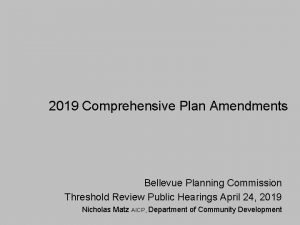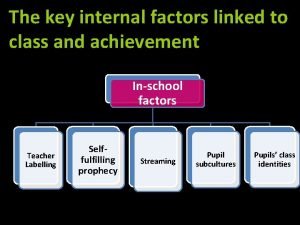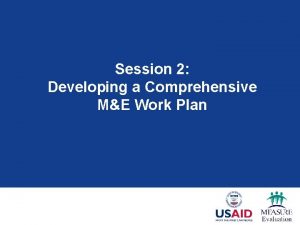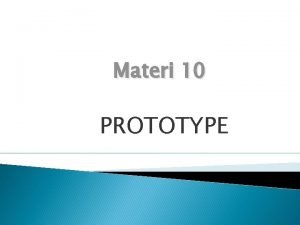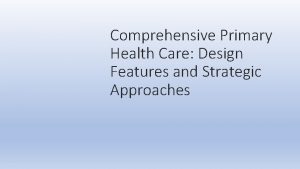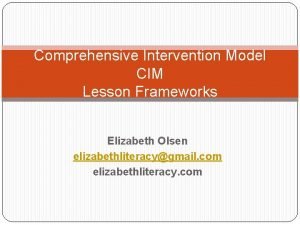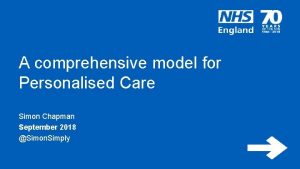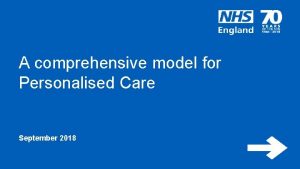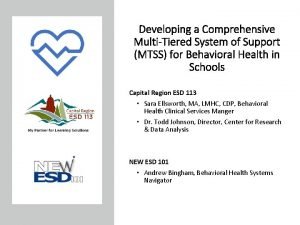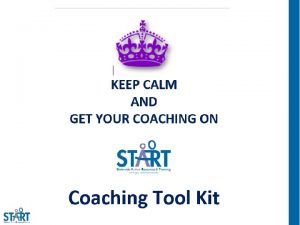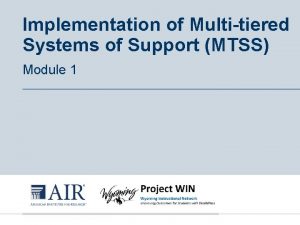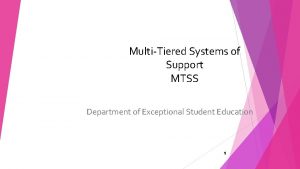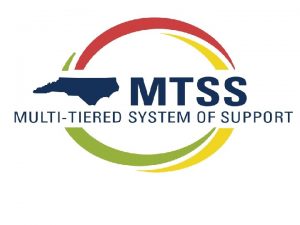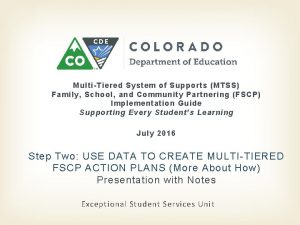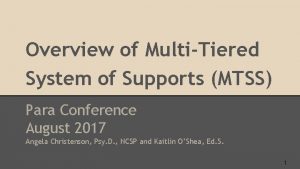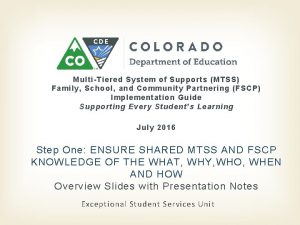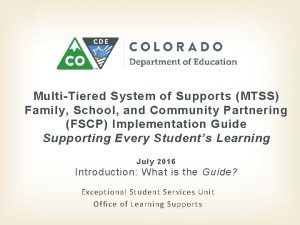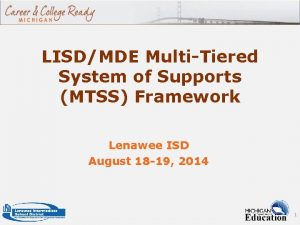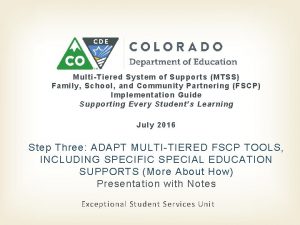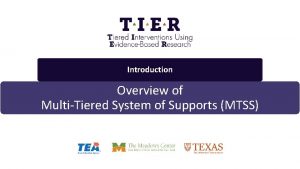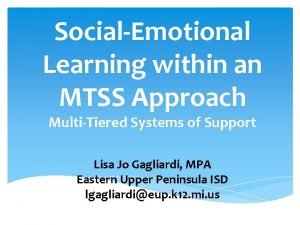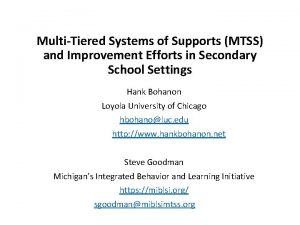Developing a Comprehensive MultiTiered System of Support MTSS

























































- Slides: 57

Developing a Comprehensive Multi-Tiered System of Support (MTSS) for Behavioral Health in Schools • Sara Ellsworth, MA, LMHC, CDP, Behavioral Health Clinical Services Manger, Capital Region ESD 113 • Matt Ishler, Principal, Rochester High School

Objectives: Developing a Comprehensive Multi-Tiered System of Support (MTSS) for Behavioral Health in Schools WHY BEHAVIORAL HEALTH IN SCHOOLS? USING A MTSS FRAMEWORK FOR BEHAVIORAL HEALTH IN SCHOOLS BENEFITS OF A SCHOOL BASED BEHAVIORAL HEALTH SYSTEM 2

Why Behavioral Health in Schools? • 3 Critical Reasons üWA state students are experiencing significant mental health issues üStudents with mental health and substance use(co-occurring) issues are less likely to graduate üStudents are not connecting with services available in the community 3

Healthy Youth Survey (2018) Washington State Students Experiencing Significant Behavioral Health Issues: Depression & Anxiety Depressive feelings Anxious Can't control worry 80% 60% 55% 50% 40% 68% 67% 70% 59% 55% 41% 40% 32% 30% 20% 10% 0% 8 th 10 th 12 th 4

Healthy Youth Survey (2018) Washington State Students Experiencing Significant Behavioral Health Issues: Suicidal Feelings & Actions Considered suicide 25% 20% Made a plan 23% 20% 22% 18% 16% Attempted 18% 15% 10% 10% 9% 5% 0% 8 th 10 th 12 th 5

Students Experiencing Significant Behavioral Health Issues: 10 th Grade Co-Occurring Conditions No Alcohol 80% No Marijuana 75% 70% 60% Alcohol 65% Marijuana 75% 65% 58% 57% 50% 40% 36% 39% 38% 36% 30% 20% 20% 10% 0% Depression Anxiety Suicide 6

Behavioral Health & Graduation 2013 DSHS Report: Key Findings • Youth with behavioral health needs were less likely to graduate from and more likely to drop out of high school than youth without behavioral health needs. Youth with co-occurring needs were the least likely to graduate on time (12%) and most-likely to drop out (80%). Graduation Rates by Category • No Known Behavioral Health Need: 63% (56% on time, 7% late) • Mental Health Only: 46% (36% on time, 10% late) • Substance Abuse Only: 25% (19% on time, 6% late) • Both Mental Health & Substance Abuse: 17% (12% on time, 5% late) FULL REPORT: https: //www. dshs. wa. gov/sesa/rda/researchreports/behavioral-health-needs-and-school-success 7

Access to Care The State of Mental Health in America 2019 • • • Washington ranks among those states with higher prevalence of youth mental illness and lower rates of access to care at 31 st overall 25 th in the Nation for children who experience a major depressive episode but did not receive mental health services 42 nd in the Nation for students identified with serious emotional disturbance for IEP Ranked 3 rd overall for Parity, with 4. 2% of children with private insurance that did not cover mental or emotional problems 13 th overall for Mental Health Workforce availability Source: http: //www. mentalhealthamerica. net/issues/state-mental-health-america 8

Access to Care Additional Considerations • Lack of resources in our rural areas • Transportation issues • Students rights to access care on their own over the age of 13 • Disruption to academics for mental health appointments in the community 9

Multi-Tiered System of Supports (MTSS) for School Behavioral Health Supports 10

What We Know… The earlier school staff can identify students’ difficulties, the quicker and less expensive the task is to help them catch up The longer a student goes without assistance, the longer the remediation time and the more intense the services must be 11

What We Know… Students receiving appropriate mental health care exhibit fewer problem behaviors and perform better in the classroom. Locating mental health services in schools increases the effectiveness of interventions and reduces barriers to care that commonly plague mental health providers. Schools and mental health providers form an important piece of the argument for coordinated in-school services. 12

Adapting Behavioral Health Services in a School Setting Traditional Mental Health ESD Integrated Framework Mental health counselor “sees” students for appointments. MH person engaged at all tiers. School aware of and engaged in interventions. MH staff use their own “language” when providing care. MH staff adapt language to fit with school language and expectations. Clinicians only “do” mental health. Mental health is everyone’s job. Clinicians contribute to integrated plan. 13

ESD 113 Behavioral Health Services Therapeutic Services Liaison Services • • • Screening/assessment Individual therapy Group therapy Family therapy Co-Occurring treatment Case management • Care coordination and referral • Linkage between outside providers and school personnel • Participation on wrap-around teams • Engagement on MTSS school-based teams 14

15

Benefits of a School Based Behavioral Health System of Care Increased access to services Provides students with tools for self-management Destigmatizes seeking mental health support Increased academics and engagement in school 16

Building School Capacity for Prevention, Early Intervention and Effective Mental Health Treatment Eric J. Bruns, Ph. D. University of Washington School of Medicine, Department of Psychiatry UW School Mental Health Assessment, Research, and Training (SMART) Center

Our Mission: To promote high-quality, culturally-responsive programming to meet the full range of social, emotional, and behavioral (SEB) needs of all students through research, training, technical assistance, and support to policy-making.

Schools play a major role in promoting the emotional wellness of our children & youth Most youth who require mental health services do not receive them Positive school climate can buffer youth from external risk factors Social-emotional learning programs improve school achievement by 11% on average (Durlak et al. , 2011) SMH accounts for >70% of all MH services – and can improve service access for underserved youth

Access ≠ Effectiveness 1. Access & Utilization of Services 2. Service Quality and Outcomes

Building a SYSTEM for responding to emerging student needs is far more effective than reacting to issues as they “pop up”. Too often our approach to responding to emerging issues in school is like the game of Whack a Mole. (Walker, B. 2018) 21

In other words, we cannot place systemic responses on the shoulders of individual educators. Dana Ashley, American Educator (2015) …or individual mental health practitioners we place in schools…

Look familiar? Multiple initiatives, programs, and practices to support student achievement Legislative priorities Function based interventions Trauma Informed practices Mc. Kinney Vento School Safety Health/Nutrition Social Emotional Learning PAX Good Behavior Game Restorative Practices Bullying Prevention Wraparound Equitable Classroom Practices Cognitive behavioral therapy Classroom Management Teaching expected behaviors Family Engagement Progress Monitoring College and Career Readiness Check In Check Out Data and Assessments Check and Connect Basic Needs Behavioral Health Cultural Responsiveness Social Skills Instruction Effective Instruction OFFICE OF SUPERINTENDENT OF PUBLIC INSTRUCTION “…what is needed is an approach that can help connect existing efforts and systems across domains and integrate the support that is already provided to students into a seamless whole” (Mc. Intosh & Goodman, 2016, p. 4). 11/26/2020 23

What is MTSS (PBIS + RTI + Other Supports)? Framework for enhancing adoption and implementation of Continuum of evidence-based strategies to achieve Academically and behaviorally important outcomes for All students

Pro tor oni gre ss m A continuum of evidence-based supports for socialemotional needs ing Multi-Tier System of Supports (MTSS) Targeted/ Intensive Tier 3 Menu of Individual Supports for a FEW: FEW, High-risk Students Individual Interventions (3 -5%) • FBA-based Behavior Intervention Plan & Replacement Behavior Training • Cognitive Behavior Therapy • “Tier 3 Wraparound” teaming Selected SOME, At-risk Students Scr een i ng Small Group & Individual Strategies (10 -25% of students) Universal ALL Students School/class-wide, Culturally Relevant Systems of Support (effective for 75 -90% of students) Tier 2 Menu of Default Supports for SOME: • Behavioral contracting • Self monitoring • School-home note / “Class pass” • Mentor-based programs • Targeted individual MH treatment • Group social-emotional skills training Tier 1 Menu of Supports for ALL: • School-wide PBIS • Positive relations with all students • Social-emotional learning (SEL) • Evidence based prevention E. g. , Good behavior Game • Proactive classroom management

What is needed to take SMH to scale WITH QUALITY? 1. 2. 3. 4. 5. Well-Accepted Implementation Structures Systematic Screening Effective School-wide / “Tier 1 Universal” Strategies Training/support on effective, efficient Tier 2 -3 models District – Community Leadership Teams – Memoranda of Agreement with providers 6. Quality Monitoring and Improvement 7. Funding to Achieve the Above and to Fill Gaps – District/LEA and Medicaid is not enough

Not another thing to add to the plate…MTSS IS the plate Attendance School Climate Academics Safety Behavior Social and Emotional Mental/Behavioral Health Dropout Prevention Physical Health Basic Needs Family, School, and Community Partnerships What is on your menu of supports to help ALL students succeed? How do you ensure equitable access to supports? Schmitz, 2016

What is needed to take SMH to scale WITH QUALITY? 1. 2. 3. 4. 5. Well-Accepted Implementation Structures Systematic Screening Effective School-wide / “Tier 1 Universal” Strategies Training/support on effective, efficient Tier 2 -3 models District – Community Leadership Teams – Memoranda of Agreement with providers 6. Quality Monitoring and Improvement 7. Funding to Achieve the Above and to Fill Gaps – District/LEA and Medicaid is not enough

Importance of Systematic Screening > Splett et al. (2018): Comparison of universal screening to traditional school identification – Study of 3, 744 students – 180% greater rate of identification with screener – 3 times more likely to identify students with internalizing disorders > Traditional approach: Identified students much more likely to be male and acting out

What is needed to take SMH to scale WITH QUALITY? 1. 2. 3. 4. 5. Well-Accepted Implementation Structures Systematic Screening Effective School-wide / “Tier 1 Universal” Strategies Training/support on effective, efficient Tier 2 -3 models District – Community Leadership Teams – Memoranda of Agreement with providers 6. Quality Monitoring and Improvement 7. Funding to Achieve the Above and to Fill Gaps – District/LEA and Medicaid is not enough

Effective School-Wide Strategies: Elements of School-wide PBIS 1. 2. 3. 4. 5. 6. 7. 8. School-wide teams with interest and commitment Data-based decision-making system Modify discipline referral process/forms Establish expectations & rules Develop lesson plans & teach Create an acknowledgement system Refine consequences Monitor, evaluate, and modify

NEA, 2014

Social emotional learning programs improve academic achievement by 11% on average

A Shift in Thinking… If a child doesn’t know how to read, we teach If a child doesn’t know how to swim, we teach If a child doesn’t know how to multiply, we teach If a child doesn’t know how to drive, Wai we teach t wha … t? ? If a child doesn’t know how to behave, we… suspend them. Why is there an overreliance on punitive strategies when it comes to behavior? What if we taught behavior, emotions, and relationships with the same amount of rigor we teach academics? adapted from John Herner, Counterpoint (1998, p. 2)

What is needed to take SMH to scale WITH QUALITY? 1. 2. 3. 4. 5. Well-Accepted Implementation Structures Systematic Screening Effective School-wide / “Tier 1 Universal” Strategies Training/support on effective, efficient Tier 2 -3 models District – Community Leadership Teams – Memoranda of Agreement with providers 6. Quality Monitoring and Improvement 7. Funding to Achieve the Above and to Fill Gaps – District/LEA and Medicaid is not enough

BRISC Overview School-Based Usual Care BRISC Intervention is often crisisdriven Structured/systematic identification of treatment targets Often focused on providing nondirective emotional support Interventions do not systematically use research evidence Focused on skill building/problem solving Standardized assessments are used infrequently Utilizes standardized assessment tools for progress monitoring All intervention elements are evidence-based

BRISC Overview > BRISC helps SBMH Provider: – Engage with students by asking about their immediate concerns – Assess issues students wants help with AND the nature of student’s needs – Teach basic tools to empower students – Decide what the best next treatment steps are

Post-BRISC pathways for three evaluation studies 60% 55% ON - Year 2 ON - Year 1 WA 50% 42% 40% 31% 30% 23% 18% 20% 8% 10% 18% 11% 17% 9% 0% Support concluded Support monitoring Continue counseling Referred to additional services

What is needed to take SMH to scale WITH QUALITY? 1. 2. 3. 4. 5. Well-Accepted Implementation Structures Systematic Screening Effective School-wide / “Tier 1 Universal” Strategies Training/support on effective, efficient Tier 2 -3 models District – Community Leadership Teams – Memoranda of Agreement with providers 6. Quality Monitoring and Improvement 7. Funding to Achieve the Above and to Fill Gaps – District/LEA and Medicaid is not enough

The MTSS Model is More Likely to Happen When Schools and Communities are in Partnership SCHOOL PROVIDERS COMMUNITY PROVIDERS 3 2 3 1 2 1

Importance of Community-School Memoranda of Understanding > Enables common expectations and move toward standardization in evidence-based assessment and practice > Providing “one door” for community mental health and other systems to come through > Creates opportunities for system collaboration, braided funding, and growth in funding to enable other system involvement in Tiers 1, 2 and 3

What is needed to take SMH to scale WITH QUALITY? 1. 2. 3. 4. 5. Well-Accepted Implementation Structures Systematic Screening Effective School-wide / “Tier 1 Universal” Strategies Training/support on effective, efficient Tier 2 -3 models District – Community Leadership Teams – Memoranda of Agreement with providers 6. Quality Monitoring and Improvement 7. Funding to Achieve the Above and to Fill Gaps – District/LEA and Medicaid is not enough

Sustainability Self-Assessment for Tier 1 MTSS for School, LEA, and SEA Teams Mc. Intosh, K. (2017). Sustainability Self-Assessment for Tier 1 MTSS. OSEP TA Center on Positive Behavioral Interventions and Supports, University of Oregon, Eugene, OR. http: //www. pbis. org/Common/Cms/files/pbisresources/SCTG%20 Tier%201%20 Sustainability%20 Self-Assessment. doc

Student outcomes: PHQ-9 (Depression) 14 12 12. 1 11. 3 10 9. 6 10. 1 8. 2 8 7. 5 6 4 ON - Current (N=94) ON - Pilot 2 WA State 0 PRE POST

Student outcomes: Self-reported Stress Rating ON - Current (N=78) 7. 0 6. 4 5. 0 4. 0 3. 0 2. 0 1. 0 0. 0 At Session 2 At Discharge

BRISC Feasibility Ratings Scale: 1 (Not at all) to 3 (Moderately) to 5 (Extremely) ON (n=106) Mean SD ON (n=35) Mean SD WA (n=30) Mean SD Usefulness of BRISC 3. 90 0. 96 3. 94 0. 73 3. 73 0. 87 Relevance of problem solving and other tools to this student 3. 91 0. 99 3. 86 0. 88 3. 70 1. 14 Extent to which clinician was able to incorporate BRISC concepts and 3. 91 0. 91 3. 89 0. 72 3. 70 0. 95 techniques into their work Compatibility of BRISC with practical realities and resources 3. 75 1. 04 3. 89 0. 86 4. 03 1. 22

What is needed to take SMH to scale WITH QUALITY? 1. 2. 3. 4. 5. Well-Accepted Implementation Structures Systematic Screening Effective School-wide / “Tier 1 Universal” Strategies Training/support on effective, efficient Tier 2 -3 models District – Community Leadership Teams – Memoranda of Agreement with providers 6. Quality Monitoring and Improvement 7. Funding to Achieve the Above and to Fill Gaps – District/LEA and Medicaid is not enough

PRIORITIES FOR WASHINGTON STATE • FUND SCHOOL MENTAL HEALTH • SUPPORT A SYSTEM of high-quality implementation of School Mental Health – Through a quality framework for MTSS + training and coaching + CQI with monitoring

Jennifer Stuber Center Director May 3, 2019

OUR MISSION Forefront Suicide Prevention is a Center of Excellence at the University of Washington focused on reducing suicide by empowering individuals and communities to take sustainable action, championing systemic change, and restoring hope.

WHAT WE’RE FACING 12 th 9% of graders report attempting suicide HYS 2 nd leading cause of death for 10 -19 year olds in Washington is suicide AFSP Hospital admissions for suicidal children ages 5 -17 doubled between 2007 -2015 National Academy of Pediatrics Friends of students who die by suicide are 5 times more likely to experience suicidal ideation

WHAT’S IN YOUR HOME? 56% of teens say it’s easy to get prescription drugs from their parents medicine cabinet 95% of parents don’t believe their child would take a prescription drug for misuse 49% of all suicides involve a firearm 82% of youth suicides by firearm involve a family firearm There is a positive association between the accessibility of firearms in the home youth suicide Acquired capability


FOREFRONT IN SCHOOLS Key element Partner FIS Level of intervention Protocol X Basic Capacity to intervene X Basic Kid finding X Basic School-wide awareness and skills X Advanced Parent education X Advanced Climate toward mental health X Mid and upstream approaches X Transformed

CRISIS PLAN CHECKLIST INFRASTRUCTURE Includes a list of school staff and others in the district who have expertise in mental health, substance use, bullying, threat assessment, suicide intervention and crisis response. PREVENTION Includes plans for training and who will facilitate. Identifies frequency with which training is offered. Content includes violence, suicide prevention and substance abuse. INTERVENTION Identifies screening tools and how they are implemented. Identifies response to suicide risk level, including notification of staff, administration, parent and/or guardian, as well as intervention options and appropriate community resources. RE-ENTRY Identifies re-engagement plan and procedures for supporting a student and family in return from extended absence. POSTVENTION Includes specific strategies for supporting students, families/staff/faculty in the aftermath of a student suicide for multiple time periods. SUPPORTING DOCUMENTS Includes scripts for office staff who answer phones, PIO’s response to media requests, notifying parents, students and staff, talking points for staff in the classroom, resources for caregivers of students at risk, re-entry checklist etc.

RESOURCES Suicide Lifeline 1. 800. 273. 8255 Crisis Text Line Text about anything Text “HEAL” to 741741 Recovery Help Line Crisis Connections Mental Health, Substance Abuse, Problem Gambling Cares Package, Mentor Support, Survivor Groups 1. 866. 789. 1511 1. 866. 427. 4747

THE ROLE OF EMPATHY • I’m listening • Thanks for telling me • Tell me more • It’s okay to be honest • You have a lot going on • I want to help • You matter LISTEN WITH EMPATHY REFELCTIV E RESPONSE S ACKNOWLE DGE THEIR PAIN
 Mtss and udl
Mtss and udl Mtss memes
Mtss memes Mtss-b
Mtss-b Mde mtss documentation packet
Mde mtss documentation packet Mtss needs assessment
Mtss needs assessment Mtss documentation packet
Mtss documentation packet Benefits of mtss
Benefits of mtss Mtss
Mtss Mtss nebraska
Mtss nebraska Trazabilidad mtss
Trazabilidad mtss Mtss infographic
Mtss infographic Indiana sel competencies
Indiana sel competencies Developing spreadsheet-based decision support systems
Developing spreadsheet-based decision support systems Process of finding errors in software code
Process of finding errors in software code Bsnl sampann
Bsnl sampann Massachusetts comprehensive assessment system
Massachusetts comprehensive assessment system Pearson access next ricas
Pearson access next ricas Ricas reference sheet
Ricas reference sheet Rhode island comprehensive assessments system
Rhode island comprehensive assessments system Grammatical signals examples
Grammatical signals examples Dss vs expert system
Dss vs expert system Difference between dss and expert system
Difference between dss and expert system Decision support system and expert system
Decision support system and expert system Brand equity management system
Brand equity management system Writing a comprehensive report in special education
Writing a comprehensive report in special education Comprehensive science villanova
Comprehensive science villanova Comprehensive care plan
Comprehensive care plan Wa.portal.cambiumast
Wa.portal.cambiumast Staxi-2 scoring
Staxi-2 scoring Comprehensive research definition
Comprehensive research definition Operating statement
Operating statement Comprehensive exams
Comprehensive exams Remedial activities for slow learners
Remedial activities for slow learners Clinical comprehensive assessment
Clinical comprehensive assessment School counseling calendar
School counseling calendar Program components
Program components Statement of comprehensive income btec business
Statement of comprehensive income btec business Exploring microsoft office excel 2016 comprehensive
Exploring microsoft office excel 2016 comprehensive Diagnosing groups and jobs
Diagnosing groups and jobs Drdp preschool comprehensive view
Drdp preschool comprehensive view Ctopp-2 score interpretation
Ctopp-2 score interpretation Comprehensive test of nonverbal intelligence
Comprehensive test of nonverbal intelligence Comprehensive safety analysis
Comprehensive safety analysis Types of comprehensive interventions
Types of comprehensive interventions Comprehensive classroom management
Comprehensive classroom management Comprehensive problem 1 part 8
Comprehensive problem 1 part 8 Hebburn comp uniform
Hebburn comp uniform 5 point rubric for writing
5 point rubric for writing Bellevue comprehensive plan
Bellevue comprehensive plan Banding at beachside comprehensive
Banding at beachside comprehensive Comprehensive work plan
Comprehensive work plan Materi didefinisikan sebagai
Materi didefinisikan sebagai Hierarchical reinforcement learning: a comprehensive survey
Hierarchical reinforcement learning: a comprehensive survey Comprehensive primary health care approach
Comprehensive primary health care approach Comprehensive intervention model
Comprehensive intervention model Air force feedback form
Air force feedback form Comprehensive model of personalised care
Comprehensive model of personalised care Comprehensive model of personalised care
Comprehensive model of personalised care


